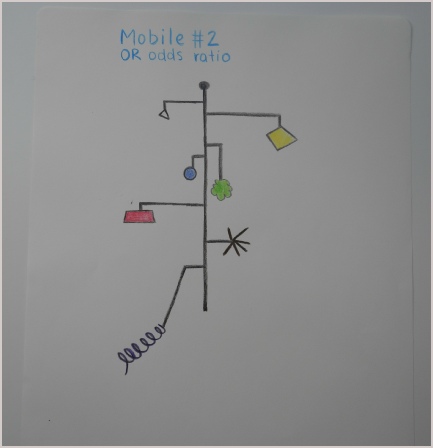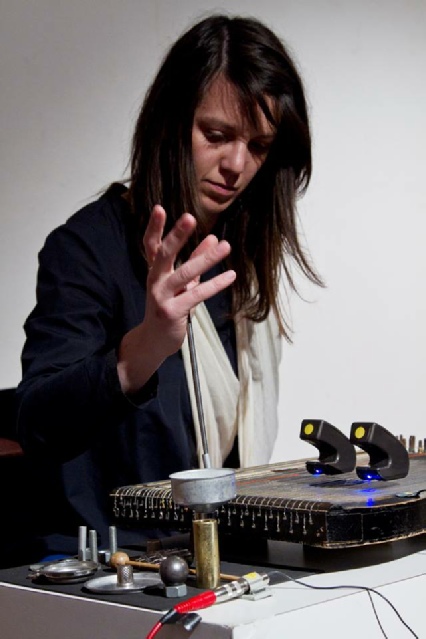Another Timbre TimHarrisonbre
Mobile #2 ‘odds ratio’
Co-ordinator Dimitra Lazaridou-Chatzigoga
with Xavier Charles, Alfredo Costa Monteiro, Ferran Fages,
Enrico Malatesta, Christian Weber & Nate Wooley
‘odds ratio’ full mix (27 minutes)
Individual files by musicians for download:
These are mp3 320 files. If you want original files, please email
info(at)anothertimbre(dot)com and we will send them to you

Text by Dimitra Lazaridou-Chatzigoga
The proposal for a mobile came while I was on holiday in Portugal – and in some way I think this had an impact on my agreeing to take it on. I remember I said yes straightaway and then I kind of let it linger for some days. On the plane back I started noting down some first ideas and thoughts, feeling quite excited. I had never coordinated a big project before, nor worked much with composition, and I was unsure about how everything would develop. I decided though to take up the challenge. I think what ‘triggered’ me most was the concept of a mobile, a modular structure, and then the idea of having an excuse to work with some people on a project.
Choosing the musicians was the first big challenge. I did not think so much about how ‘easily’ people would fit together. I decided to take it more as a personal choice and initially follow Barry Chabala’s idea of working with people with whom I had not collaborated at length before. Most of them eventually ended up being people who I’ve met in different places, or people whose music had for some reason or other been significant for me. I guess you could say it was as if I was collecting some seeds, or better, the fruits of some seeds, that I had sown in different places and at different times- without being conscious of it.
I met Nate Wooley in early 2012 at a concert in London, after enjoying listening to his music, and I stayed in touch with him. While I was in New York on a short visit, he proposed a gig in Philadelphia, which I had to turn down unfortunately because the date was right after my return to London. But that was the seed for something.
With Cremaster my history goes way back to when I first met and heard them live in Barcelona in 2006. They had been my ‘heroes’ for a while and I finally met them quite unexpectedly at a gig at which they were not originally supposed to play. I remember chatting with Alfredo after the concert and acquiring their ‘live at sound323’ album. Several months later I started playing with Ferran (as ap’strophe) and being involved in music. I have been a Cremaster ‘groupie’ for many years, so it has been great to actually be able to work together.
I met Enrico Malatesta at the Personal and Collective festival that Seijiro Murayama organized in Ljubljana in the summer of 2011. It was a turning point for me, because it was only a few days before I moved from Athens to London. We played in some bigger formation, as far as I recall, but didn’t really have the time to play more, something we both thought would be interesting.
With Xavier Charles and Christian Weber, the situation is quite different. I have never met them in person, but I have enjoyed their music for quite a while; they are both the kind of player who seems to have found a distinctive sound on their instrument. Xavier’s trio with Axel Dörner and John Butcher, ‘the contest of pleasures’ had a great impact on me when I first heard it, as well as his collaboration with the Ex, and his 2010 clarinet solo ‘invisible’ on Sofa Records. I remember Christian’s sound from when I first heard his music in Mersault (with Tomas Korber and Christian Wolfarth), and I recently liked his Walcheturm solo very much.
In a way I tried to assemble a dream band to perform the piece, taking advantage of the fact that the musicians involved would not be all in one place to do it - rather, physical distance was sought for. But that said, I did think of how they would all sound together. I love electronics and brass & woodwind instruments, especially the trumpet and the clarinet, so these things just popped up in my mind. I tried to avoid string players, since I’ve played and have been around many string instruments in the last few years. I did finally include a double bass, because I thought it would give some grounding to the more ‘airy’ sounds. Plus, percussion, which I felt would give some granularity to the overall sound.
When I tried to put my ideas to paper, I wanted to combine the general schema of the project provided by Simon Reynell with my personal view, so I drew an archetype of a mobile that would serve as an image for my score. I visited then the Tate Modern to experience a mobile by Alexander Calder. The room was packed with people and the mobile was hanging from the ceiling, interestingly influenced by the buzz and movements of people and by the air that flew past it. Slight changes in the weight of its parts would make it turn, stand still again, find a new position for a while. I retained this image/experience in my mind while working on the score. I wrote some instructions that the participants could take into account, but basically other than the length of the whole piece (27 minutes) and their individual contributions (13 minutes), there wasn’t much else predetermined.
The subtitle of the piece ‘OR odds ratio’ adds a notion used in statistics, where the odds is the probability that a particular event will occur compared to the probability that it will not occur. Thus, the musicians being exposed to a partial product that they themselves shape have to take into account sound events that have or have not occurred, and, at the same time, they anticipate the actions the rest of the players might perform considering all possible worlds. That was a substantial part of the process for everybody, except perhaps for the last player, whose calculations of odds were different in that sense, though not totally detached from the whole process.
Once everybody had agreed to take part, the next thing was to decide on the order. One important decision for me was to decide where I would be in the process. Being the composer and taking part in the music was a tricky thing, so I decided it would be best to be neither at the beginning nor the end. That way I would avoid ‘shaping’ the music too much, making it more my own that I wanted to, setting the tone or giving the final touch. So, I decided I would be somewhere in the middle. There were six musicians involved (counting Cremaster as one) and the project had a quite strict timeline leaving the musicians each about 3 weeks to complete their contribution. Given this, I was very surprised that we could actually work out an order that fitted everybody’s schedule. I decided that Nate would be the first musician because he had been the first to accept the proposal. The rest of the order was based more on availability than on who would listen to whom. In essence it was a practical decision rather than an imposed order, allowing people to be comfortable with the shape the mobile was taking even before it was played.
So, as it worked out, I was fourth to record, with two more contributions after me. It was not at all unnerving to send my part off when I had completed it; I would say it was a relief to know that there were more musicians coming after me. Having almost always worked very closely with other musicians in the past, it was unsettling to make decisions about the material on my own, and at the same time to try to be just another participant in a project I was coordinating. This new situation made me work and mix/process my sounds after playing, something I had never done before.
It was quite impressive that the whole process went so smoothly after everything was set in place. All the participants kept to their deadlines; I was really surprised. The project started sometime in July and its completion was my New Year’s Eve present!
I am not sure I was anticipating anything in particular. At several points, I felt unsure about how the combination of so many people would turn out, thinking it might end up being too full of music. Sometimes a new contribution would feel awkward, but it would find its place after the next one was added to the mobile. As the piece was growing, it was a new experience to feel that I had already ‘learned’ some parts of the composition, to which my ear had to add the new ones. Given the nature of the music I have mostly done thus far, it was a new experience for me to build a composition, where I would actually know which sounds would come at what points. The end result was in a sense much more than I had anticipated; I must admit I am very happy with it, so I am curious to see how other people will react to it.
One thing that seemed quite intriguing while experiencing the piece unfolding was the silence around the 5th minute that was there since the beginning and everybody respected that space, not wanting to fill it with sound. Another interesting thing about the structure of the piece is that the first sound is played by the last player to record, and the last sound is played by the first player.
Comparing my mobile to Barry’s seems an obvious thing to do, given that the underlying idea is the same. But I don’t have much to say about why I think the piece turned out so differently from Barry’s, beyond that different people and ideas were involved. The nature of mobile structures is closely tied to balance, imbalance and equilibrium in between, so the whole structure depends on the nature of its parts, in the same way that a sentence is composed by the meaning of its parts, and, also, by the way these meanings are put together. Thus, different meanings arose from the variation of the ‘syntactic rules’ that the players chose to employ; modifying a sound in a sound/music structure, as they would change the position of a word in a sentence.
Dimitra Lazaridou-Chatzigoga, March 2014

www.vudunoeuf.asso.fr/xavier/english.html (Xavier Charles)
www.strokebystroke.net/ (Dimitra Lazaridou-Chatzigoga)
http://www.christianweber.org/
